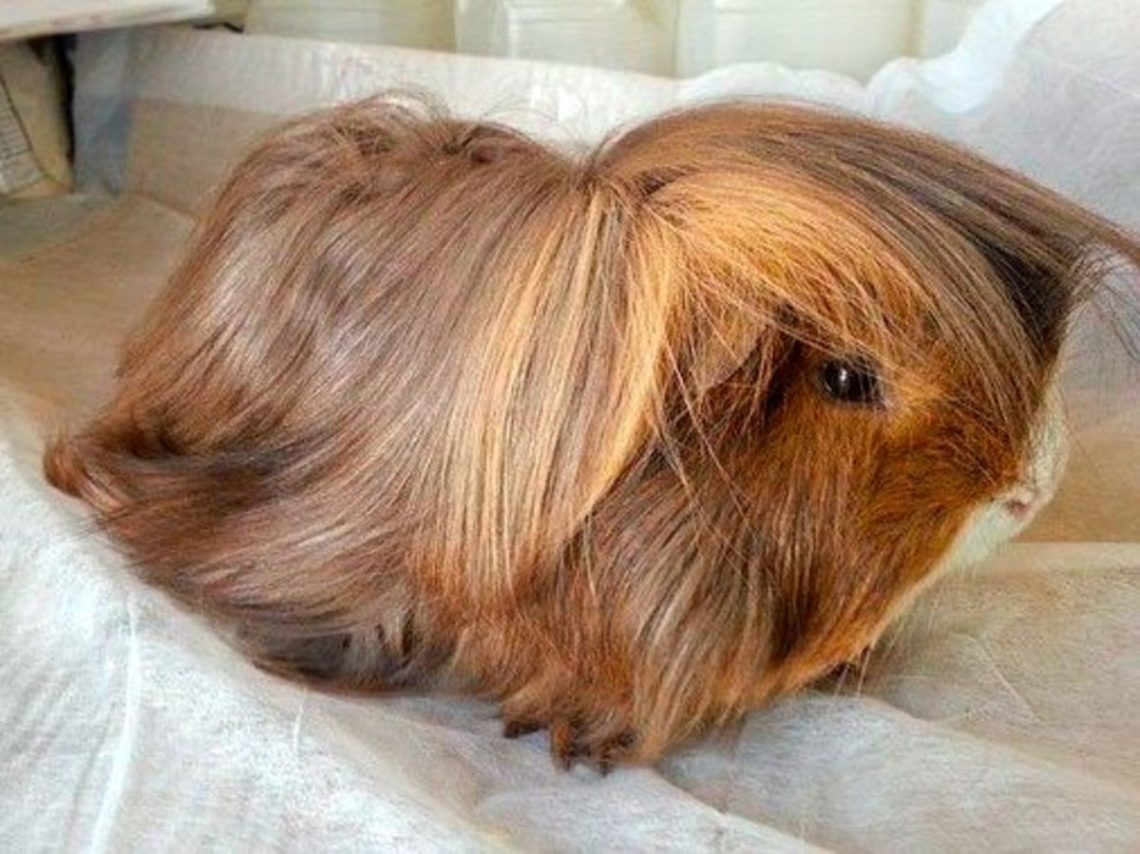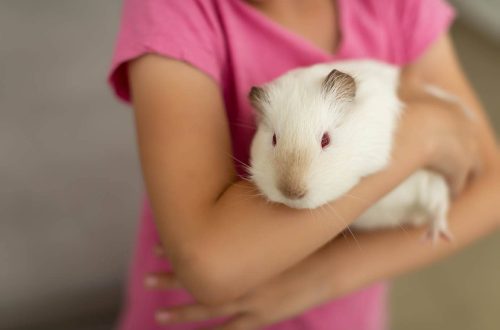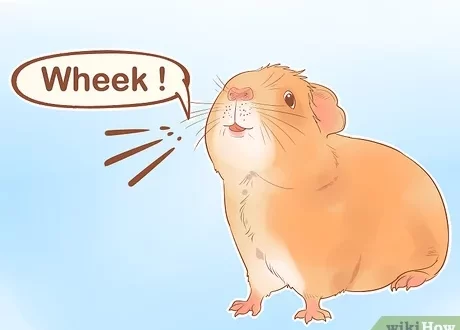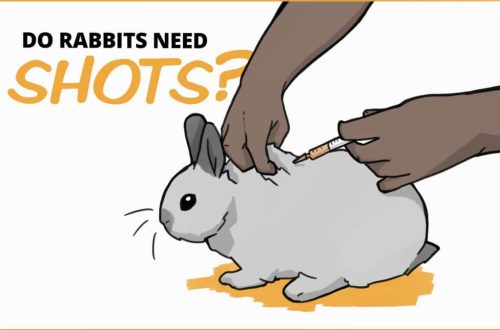
Long haired guinea pigs: grooming
Long-haired breeds of pigs require special care, a lot of time and effort, and most importantly, great patience. They need to be combed out daily and the hair removed in specially prepared papillots, otherwise their hair will stray into tangles and have an untidy appearance. Pigs may gnaw or chew on their fur, most commonly when kept in groups or pairs. This can also be done by pregnant females, who “cut off” the male’s hair. Usually this situation occurs if the animals lack minerals and vitamins. Your task is to think over the diet and achieve a balanced diet for your pet.
Difficulties in caring for long-haired animals also arise during the molting period. Pigs molt twice a year. Autumn molting occurs at the end of August – beginning of autumn, and spring – at the end of February – beginning of March. The duration of the molt is 3-4 weeks. In order for this period to pass relatively painlessly and not cause unpleasant consequences, I recommend combing your pet most carefully and taking care of a good balanced diet. It is also good to give the animals vitamin C mixed with a 40% glucose solution before molting and during molting. It is useful to add dried nettles to the animal’s diet to strengthen wool.
Thus, when caring for long-haired pets, everything is special, from bathing him to removing papillots from his hair. In this article, I will try to cover everything you need when caring for a long-haired piglet.
Long-haired breeds of pigs require special care, a lot of time and effort, and most importantly, great patience. They need to be combed out daily and the hair removed in specially prepared papillots, otherwise their hair will stray into tangles and have an untidy appearance. Pigs may gnaw or chew on their fur, most commonly when kept in groups or pairs. This can also be done by pregnant females, who “cut off” the male’s hair. Usually this situation occurs if the animals lack minerals and vitamins. Your task is to think over the diet and achieve a balanced diet for your pet.
Difficulties in caring for long-haired animals also arise during the molting period. Pigs molt twice a year. Autumn molting occurs at the end of August – beginning of autumn, and spring – at the end of February – beginning of March. The duration of the molt is 3-4 weeks. In order for this period to pass relatively painlessly and not cause unpleasant consequences, I recommend combing your pet most carefully and taking care of a good balanced diet. It is also good to give the animals vitamin C mixed with a 40% glucose solution before molting and during molting. It is useful to add dried nettles to the animal’s diet to strengthen wool.
Thus, when caring for long-haired pets, everything is special, from bathing him to removing papillots from his hair. In this article, I will try to cover everything you need when caring for a long-haired piglet.
Bathing long haired guinea pigs
Bathe guinea pigs only when necessary. For example, if his fur coat is dirty or if you are going to exhibit it at an exhibition.
Before bathing, comb out the pig’s fur as best as possible. Fill the sink with warm water and stir the shampoo in it. Place your pet in the sink with its head on top of the water. Wet the pig’s fur, and gently rub the shampoo into it. Note: it is better not to lather the pig’s head, it is enough to wipe it with wet hands.
Pet stores have a variety of detergents from different companies. They are divided into products specifically designed for dogs, cats and rodents. You can use any shampoo, but keep in mind that shampoos for dogs and cats are the most concentrated and can irritate the skin of rodents, so they must be diluted with water before use.
In my experience, it’s better to use shampoos that are specifically designed for a particular coat color, as they enhance the color, add brightness and extra shine to the hair. I recommend using Bio-Groom detergents for white, bronze and dark colors.
On a note. Caring for a piglet is more difficult if it is white. Undoubtedly, food dyes from food are easily washed off with plain water, but urea that has eaten into wool cannot be washed off with any shampoo. In this case, I recommend wiping the contaminated areas with lemon juice, and then sprinkle with hair powder. The yellowness will not completely disappear, but will turn pale significantly.
After you have washed your pet, rinse the shampoo well. Then take the pig out of the water, wring out its “tail” in your hands and carefully dry its hair with a towel. Then long-haired animals must be dried with a hair dryer with a cold or warm air stream. Never dry with hot air, as it dries out and breaks the hair. Before using a hair dryer, to avoid the formation of tangles and magnetization of wool, use an antistatic agent. I recommend using Coat gloss for cats. Important. Do not comb wet hair as it breaks.
After you have dried the piglet, you need to carefully comb the fur. If the wool is tangled and strayed into a tangle, it must be carefully disassembled by hand. If the mat cannot be disassembled, if necessary, it can be cut with scissors. This must be done very carefully so as not to injure the pig, using scissors with blunt ends. Carefully slide the scissors under the tangle so that when cutting you do not accidentally cut off a piece of skin with wool.
Bathe guinea pigs only when necessary. For example, if his fur coat is dirty or if you are going to exhibit it at an exhibition.
Before bathing, comb out the pig’s fur as best as possible. Fill the sink with warm water and stir the shampoo in it. Place your pet in the sink with its head on top of the water. Wet the pig’s fur, and gently rub the shampoo into it. Note: it is better not to lather the pig’s head, it is enough to wipe it with wet hands.
Pet stores have a variety of detergents from different companies. They are divided into products specifically designed for dogs, cats and rodents. You can use any shampoo, but keep in mind that shampoos for dogs and cats are the most concentrated and can irritate the skin of rodents, so they must be diluted with water before use.
In my experience, it’s better to use shampoos that are specifically designed for a particular coat color, as they enhance the color, add brightness and extra shine to the hair. I recommend using Bio-Groom detergents for white, bronze and dark colors.
On a note. Caring for a piglet is more difficult if it is white. Undoubtedly, food dyes from food are easily washed off with plain water, but urea that has eaten into wool cannot be washed off with any shampoo. In this case, I recommend wiping the contaminated areas with lemon juice, and then sprinkle with hair powder. The yellowness will not completely disappear, but will turn pale significantly.
After you have washed your pet, rinse the shampoo well. Then take the pig out of the water, wring out its “tail” in your hands and carefully dry its hair with a towel. Then long-haired animals must be dried with a hair dryer with a cold or warm air stream. Never dry with hot air, as it dries out and breaks the hair. Before using a hair dryer, to avoid the formation of tangles and magnetization of wool, use an antistatic agent. I recommend using Coat gloss for cats. Important. Do not comb wet hair as it breaks.
After you have dried the piglet, you need to carefully comb the fur. If the wool is tangled and strayed into a tangle, it must be carefully disassembled by hand. If the mat cannot be disassembled, if necessary, it can be cut with scissors. This must be done very carefully so as not to injure the pig, using scissors with blunt ends. Carefully slide the scissors under the tangle so that when cutting you do not accidentally cut off a piece of skin with wool.
Combs for guinea pigs
Currently, there is a huge variety of combs, brushes, “slickers” on sale. In principle, you can use any comb that your pig is accustomed to and that is comfortable for you. In my opinion, it is necessary to have two main combs. First, it’s a comb. It can be either metal or plastic. I prefer using a metal comb. It is better to purchase a double-sided comb, when the teeth are located more often on one side, and less frequently on the other.
Secondly, it is a soft brush. It has the effect of a massage brush, combs out dead hairs well and massages the skin.
Important. At the exhibitions, I have repeatedly observed how most of the participants use exclusively the so-called “slickers”. I am categorically against their use, because they pull out and whip the hair. They may be good to use if you have a short-haired animal, but in no case do I recommend using them if you have a long-haired pig.
Currently, there is a huge variety of combs, brushes, “slickers” on sale. In principle, you can use any comb that your pig is accustomed to and that is comfortable for you. In my opinion, it is necessary to have two main combs. First, it’s a comb. It can be either metal or plastic. I prefer using a metal comb. It is better to purchase a double-sided comb, when the teeth are located more often on one side, and less frequently on the other.
Secondly, it is a soft brush. It has the effect of a massage brush, combs out dead hairs well and massages the skin.
Important. At the exhibitions, I have repeatedly observed how most of the participants use exclusively the so-called “slickers”. I am categorically against their use, because they pull out and whip the hair. They may be good to use if you have a short-haired animal, but in no case do I recommend using them if you have a long-haired pig.
Papillottes for guinea pigs
Papillottes are pieces of paper into which strands of hair are placed, and rubber bands that are designed to hold them together. Papillots can be made from improvised means yourself or bought at a pet store. If you make them yourself, then you can use either pieces of fabric or pieces of paper as a material. As a rubber band, you can use a piece of a balloon or a small hair tie. My experience shows that it is better to buy special paper for curlers and elastic bands specially designed for it.
For more information on how to wind the guinea pig curlers – in the article “Guinea pig curlers”
There are three types of paper for papillots. Yes, there is rice paper. She is usually white. In my opinion, this is the softest paper, hair grows very well in it, as it is natural and breathes well. Among its shortcomings, I can name the following: it breaks very quickly, gets wet and its length is no more than 15 cm, therefore, it cannot be used on long wool.
The other two types are synthetic paper. It can have an oilcloth or paper structure. The first is green, does not tear or get dirty, and its plus is that it is the longest, about 35 cm. The second, usually pink, it quickly tears and gets wet, like rice paper. On a note. It is very difficult to put curlers when your adult pig has a hair length of 40 cm or more, and it is impossible to find paper longer than 35 cm. In this case, the hair can be folded into two layers, that is, remove the hair into a hairpin, close it, and then bend the protruding tip under the second layer of paper and then twist and secure the hairpin.
Rubber bands sold at the pet store vary in size and elasticity. When buying them, you need to choose the size and elasticity based on the length and density of your pet’s coat. So, for example, the younger your pig, the shorter you need to buy paper and the smaller and thinner you need to pick up an elastic band.
Technique for setting and removing papillots
Long haired guinea pigs need to be brushed and combed daily. Tame your pig to this procedure should be from a very young age. Take your pet on your lap, comb your hair with a comb. When combing, remember that guinea pigs do not like sharp touches on the back of the back, so combing the upper back should be done very carefully and gently. Wool can be slightly moistened with an antistatic agent, then the comb will touch the hair less. The first papillotte of a piglet can be placed already at the age of about two months. And don’t let it stop you that your pet is still only a “fluffy lump”, since up to three months only one curl is required on a train (wool around the buttocks). Then, at the age of about three months, you need to start putting side curls. I do not recommend immediately putting them on the train and on the sides, in my experience it is better to put only two side curlers at this age. To do this, divide the wool into a parting and collect it from each side.
Later, at the age of 4-5 months, you need to put three papillots, one on the train and one on each side.
By 6-7 months, you can put 5 papillots (a train and two from each side).
Important! Remember, if you do not gradually braid all the hair, they begin to grow unevenly, that is, a long tail is obtained, and the hair slightly touches the ground from the sides. In the future, you can put 7 papillots, namely, add one more to the piglet’s sideburns. But, their setting depends on your pet. The pig alone cannot reach the side curlers and the curler on the train, but the curlers near the head can be willingly plucked, unfortunately, along with the hair. Therefore, in this case, be careful.
So, you have prepared paper, rubber bands and are ready to comb your piglet. In order to put the papillot, you first need to cut the paper so that its width is about 6 cm, and in length it is 2 – 2,5 cm longer than the hair. Interesting. My experience has shown that if the papillot is much longer than the hair, the hair in it grows very badly.
After that, a sheet of paper must be bent so that two folds and three edges are obtained. Then unfold the sheet of paper. Pig’s hair is divided into a parting and divided into strands. We take the prepared sheet of paper, put a strand of hair on it in the center and close the sheet of paper, first from one side and then from the other side. In this case, the wool must be removed so that the hair does not come out. Then we begin to fold the paper from the end to the roots of the hair, the number of turns depends on the length of the hair, at the end we fix the papillot with an elastic band (usually two turns). Important. The papillote should not fit close to the roots of the hair, the distance from the skin to the beginning of the sheet of paper should be approximately 0,3-0,5 cm, depending on the length of the pig’s hair. After you have placed the curler, check if you have pulled individual hairs and if any curler is causing discomfort.
Always remember that the piglet’s hair grows back the way you put it in hairpins. Therefore, try to keep the hair strands the same thickness when collecting, and put the curlers in the direction of hair growth, without pulling them to the tail, otherwise, the side hair grows poorly, only a train develops.
When removing the hairpins, first untie the elastic, then remove the paper, then pull out all the sawdust that is tangled in the hair, and then you can comb and repeat the procedure again. Remember, if you comb and braid your pig every day, you will avoid the formation of tangles.
Papillottes are pieces of paper into which strands of hair are placed, and rubber bands that are designed to hold them together. Papillots can be made from improvised means yourself or bought at a pet store. If you make them yourself, then you can use either pieces of fabric or pieces of paper as a material. As a rubber band, you can use a piece of a balloon or a small hair tie. My experience shows that it is better to buy special paper for curlers and elastic bands specially designed for it.
For more information on how to wind the guinea pig curlers – in the article “Guinea pig curlers”
There are three types of paper for papillots. Yes, there is rice paper. She is usually white. In my opinion, this is the softest paper, hair grows very well in it, as it is natural and breathes well. Among its shortcomings, I can name the following: it breaks very quickly, gets wet and its length is no more than 15 cm, therefore, it cannot be used on long wool.
The other two types are synthetic paper. It can have an oilcloth or paper structure. The first is green, does not tear or get dirty, and its plus is that it is the longest, about 35 cm. The second, usually pink, it quickly tears and gets wet, like rice paper. On a note. It is very difficult to put curlers when your adult pig has a hair length of 40 cm or more, and it is impossible to find paper longer than 35 cm. In this case, the hair can be folded into two layers, that is, remove the hair into a hairpin, close it, and then bend the protruding tip under the second layer of paper and then twist and secure the hairpin.
Rubber bands sold at the pet store vary in size and elasticity. When buying them, you need to choose the size and elasticity based on the length and density of your pet’s coat. So, for example, the younger your pig, the shorter you need to buy paper and the smaller and thinner you need to pick up an elastic band.
Technique for setting and removing papillots
Long haired guinea pigs need to be brushed and combed daily. Tame your pig to this procedure should be from a very young age. Take your pet on your lap, comb your hair with a comb. When combing, remember that guinea pigs do not like sharp touches on the back of the back, so combing the upper back should be done very carefully and gently. Wool can be slightly moistened with an antistatic agent, then the comb will touch the hair less. The first papillotte of a piglet can be placed already at the age of about two months. And don’t let it stop you that your pet is still only a “fluffy lump”, since up to three months only one curl is required on a train (wool around the buttocks). Then, at the age of about three months, you need to start putting side curls. I do not recommend immediately putting them on the train and on the sides, in my experience it is better to put only two side curlers at this age. To do this, divide the wool into a parting and collect it from each side.
Later, at the age of 4-5 months, you need to put three papillots, one on the train and one on each side.
By 6-7 months, you can put 5 papillots (a train and two from each side).
Important! Remember, if you do not gradually braid all the hair, they begin to grow unevenly, that is, a long tail is obtained, and the hair slightly touches the ground from the sides. In the future, you can put 7 papillots, namely, add one more to the piglet’s sideburns. But, their setting depends on your pet. The pig alone cannot reach the side curlers and the curler on the train, but the curlers near the head can be willingly plucked, unfortunately, along with the hair. Therefore, in this case, be careful.
So, you have prepared paper, rubber bands and are ready to comb your piglet. In order to put the papillot, you first need to cut the paper so that its width is about 6 cm, and in length it is 2 – 2,5 cm longer than the hair. Interesting. My experience has shown that if the papillot is much longer than the hair, the hair in it grows very badly.
After that, a sheet of paper must be bent so that two folds and three edges are obtained. Then unfold the sheet of paper. Pig’s hair is divided into a parting and divided into strands. We take the prepared sheet of paper, put a strand of hair on it in the center and close the sheet of paper, first from one side and then from the other side. In this case, the wool must be removed so that the hair does not come out. Then we begin to fold the paper from the end to the roots of the hair, the number of turns depends on the length of the hair, at the end we fix the papillot with an elastic band (usually two turns). Important. The papillote should not fit close to the roots of the hair, the distance from the skin to the beginning of the sheet of paper should be approximately 0,3-0,5 cm, depending on the length of the pig’s hair. After you have placed the curler, check if you have pulled individual hairs and if any curler is causing discomfort.
Always remember that the piglet’s hair grows back the way you put it in hairpins. Therefore, try to keep the hair strands the same thickness when collecting, and put the curlers in the direction of hair growth, without pulling them to the tail, otherwise, the side hair grows poorly, only a train develops.
When removing the hairpins, first untie the elastic, then remove the paper, then pull out all the sawdust that is tangled in the hair, and then you can comb and repeat the procedure again. Remember, if you comb and braid your pig every day, you will avoid the formation of tangles.
Caring for longhaired animals is a lot of work and a lot of time. And if your pig has a “character”, it will also have to be accustomed to this procedure. But, believe me, all your work will certainly pay off with joy and delight from the extraordinary beauty of your pet!
© Marina Gulyakevich, owner Tutti Futti Christiana (Sheltie, white), winner of the I Specialized Guinea Pigs Show with inter-expertise from Denmark, CACIB – Candidate for International Champions
Caring for longhaired animals is a lot of work and a lot of time. And if your pig has a “character”, it will also have to be accustomed to this procedure. But, believe me, all your work will certainly pay off with joy and delight from the extraordinary beauty of your pet!
© Marina Gulyakevich, owner Tutti Futti Christiana (Sheltie, white), winner of the I Specialized Guinea Pigs Show with inter-expertise from Denmark, CACIB – Candidate for International Champions





